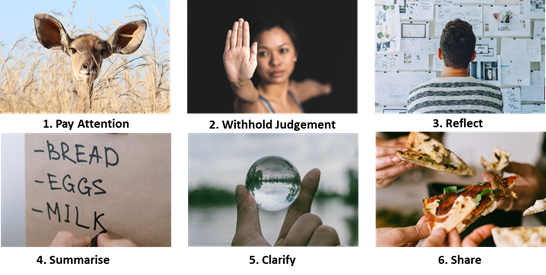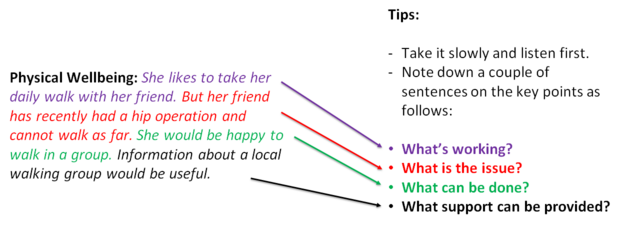Guided Conversations.Tips and Training
Guided Conversations can take many forms. However, there are key skills that need to be considered during the use of any Guided Conversation. Training sessions for individuals that will be conducting Guided Conversations are best when they take place in a comfortable and informal environment.
Before covering content on Guided Conversation skills, the team of individuals who are preparing to conduct Guided Conversations should get to know each other and think about the purpose of their specific Guided Conversation. In HAIRE, ageing was a key element of the Guided Conversation's purpose. A creative workshop, e.g. a simple poetry session, can help individuals share their thoughts and get to know each other. Guidance for a poetry session, compiled by Kelly Stevens, University of Exeter, can be seen here: Poetry Workshop Guidance
The session linked to above covered the meaning of ageing, but this topic can be changed to any main interest that is relevant to a Guided Conversation.
Skills that are relevant to conducting Guided Conversations are covered below:
Building relationships
Guided Conversations have the potential to cover personal and sensitive experiences. Participants should feel comfortable with their environment and the individual that is conducting the conversation.
Before starting a Guided Conversation, it can be helpful to take the time to engage in general chat - talking about the weather or something positive that you notice about the person and/or wherever the Guided Conversation is taking place can help to create a more comfortable atmosphere.
Using creative prompts and asking questions
Guided Conversations allow individuals to talk about what matters to them, their opinions and experiences. To help, we recommend that open questions are used by individuals who are conducting the Guided Conversations. Open questions help in generating in-depth responses - typically, they begin with "how..", "what" and "why.."
It is important that the first question asked is open and links to the Guided Conversation's main purpose. Creative prompts can be used at the start to help with conversation. In HAIRE's Guided Conversation, participants were shown the creative collages that were relevant to their local area and asked:
"How do you find living here? - this image [the creative prompt] might help you think about your local area."
This is when Active Listening becomes important. Active Listening is covered in more detail in the next section. Guided Conversations may have sub-topics of interest, but what the participant is saying should guide where the conversation goes next. Importantly, the sub-topics that a Guided Conversation contains should not be followed in order.
The moto is: Go where the participant take you! See example below:
Response to "how do you find living here?"
If included in a Guided Conversation as a sub-topic of interest, this response might lead to asking about someone’s identity and belonging or someone’s family and friends. There is no right way to go! The important skill is to build on what the participant is saying - either of the following questions can be asked to build on what the participant said:
Active Listening
Active Listening helps in supporting a conversation that is guided by a participant. The key features of Active Listening are as follows:
In terms of Guided Conversations, the following steps can help:
i) Taking an active interest in what a participant is saying (1. Pay Attention);
ii) Refraining from imposing one's own beliefs on someone’s opinions (2. Withold Judgement);
iii) Staying attentive to what can be asked next to understand a person’s experiences and opinions in relation to what a Guided Conversation aims to explore, as explained in the previous section (3. Reflect);
iv) Taking notes (if relevant) that are structured to summarise the key points of what is being said (the next section covers taking notes in more detail) – usually, capturing positives, key issues, anything that can be done to address such issues (including actions that the individual can do) and any support that can be provided to address someone’s problems works well (4. Summarise);
v) Asking follow-up questions to understand points of conversation that seem unclear (e.g. “so you mentioned that your relationship with the local area was ‘up and down’, what do you mean by that?”). This point is important for understanding certain issues and what can be done to support a person to navigate those issues (5. Clarity);
vi) Explaining to participants the key points that were captured from the conversation. This can be done via sharing any notes that were taken and/or explaining a summary of the conversation to the participant at a later date. Here, an opportunity is provided for a participant to confirm and reflect on what is important for them (6. Share).
Taking notes
It is important to find ways to capture information during a Guided Conversation that suits both the participant and the person conducting a Guided Conversation. If a Guided Conversation is part of an in-depth research project, audio recordings of conversations can help with analysis after the conversation. However, recordings can be difficult to organise, manage and store.
Notes: In HAIRE, structured notes helped to capture key points in Guided Conversations. The diagram below shows how notes can be structured to capture key points:
Using radar diagrams (if included in a Guided Conversation)
Although not essential, radar diagrams can help in providing an overview of how participants feel about certain sub-topics (if included) in a Guided Conversation. Radar diagrams record a score that participants may choose to give in relation to a sub-topic that is included in a Guided Conversation. During conversations, participants tend to pause as they are nearing the end of what they have to say in relation to a topic of conversation. These moments will arise throughout a Guided Conversation.
If the topic that a participant is speaking about is relevant to a sub-topic of interest, these natural pauses provide an opportunity for participants to score how they feel about that topic. For example, if someone seems like they are nearing the end of talking about their friends and/or family and this is of direct interest for a Guided Conversation, the following can be asked to invite a score:
“OK, so, if you had to score how you feel about your relationships with your family and friends out of 7, what would you give it? – don’t worry about it if you don’t want to give a score.”
Note: In the case above, 7 is the best score and 1 is the worst score. The scoring system used in a specific Guided Conversation should be explained to a participant before the conversation starts. For ease, we recommend using 1-7, as done in HAIRE.
A reminder of what a radar diagram looks like is provided below:Dealing with difficult conversations
Emotional conversations can be encountered during Guided Conversations. Participants can get emotional when talking about difficult life experiences. In such circumstances, the best thing to do is to pause and allow participants to take the time that they need. Participants can be reassured with a simple phrase like, "it's OK", because it is OK to get emotional!
Importantly, conversations do not have to continue! Participants can be reminded that they do not have to talk about anything that they do not wish to discuss.
HAIRE's partners, Devon Mind, produced some added guidance around difficult topics of conversation (e.g. suicide and depression), see the guidance here: Guidance for conversations around suicide and depression
Emotional conversations can impact on the individuals listening to them too. Time and space should be given to individuals who conduct Guided Conversations to meet and talk about the conversations that they have been having. The importance of confidentiality should be stressed. Personal details about participants should not be shared!
A dedicated meeting point and a regular time (e.g. weekly) to meet and share experiences can support a team who is delivering Guided Conversations.
It helps if someone who is responsible for the team is present at these meetings to remind individuals that they are supported and that their comfort is as important as the participants. Some tea, coffee and other refreshments are also recommended!
Once the skills covered above have been discussed, the team who will be conducting Guided Conversations should familiarise themselves with a Guided Conversation's materials. The best way to become familiar with a specific Guided Conversation's materials is to practise! Before using the materials with participants, individuals who will be conducting Guided Conversations should spend at least one hour doing mock Guided Conversations. This can be done with other members of the team during a session that is dedicated to practising Guided Conversations.
Referenties
- Guidance for conversations around suicide and depression, Devon Mind, UK, Devon Mind, UK, 30 maart 2023.
- HAIRE Poetry Workshop Guidance, University of Exeter, University of Exeter, 30 maart 2023.






